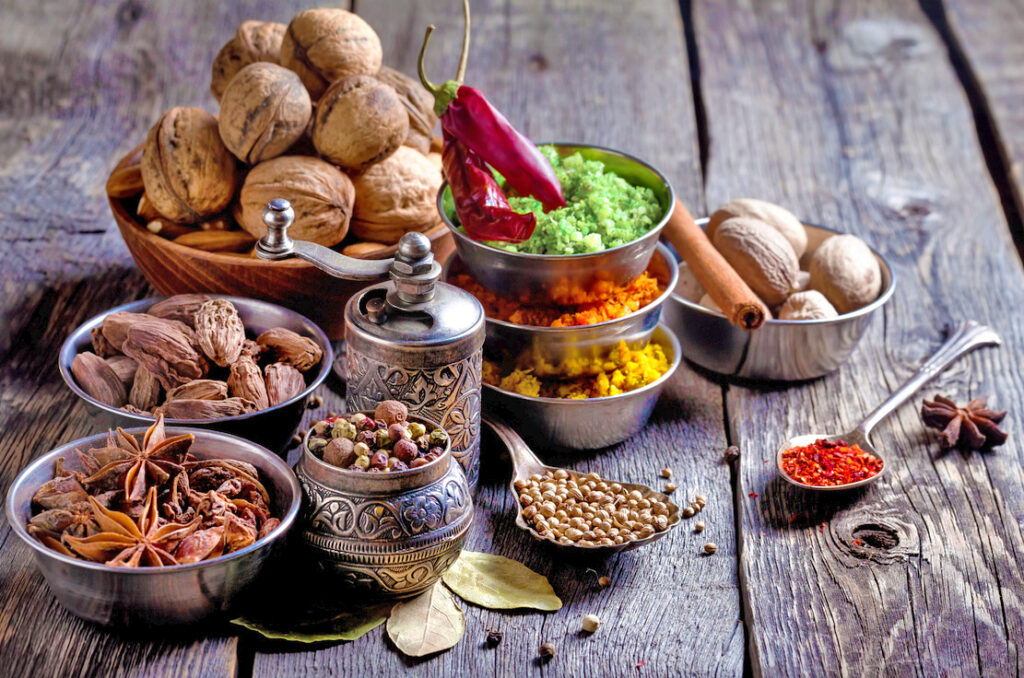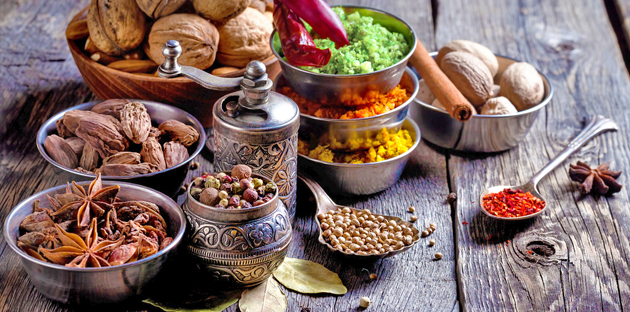Ayurveda, The Science of Life
You’ve likely heard of the ancient Indian system of healing known as Ayurveda, translated to ‘the Science of Life.’ This 10,000 year old system has withstood the test of time and has been gaining incredible popularity around the world in recent years for one main reason: it really works!
The wisdom of Ayurveda is a culmination of knowledge from the meditative minds and hearts of countless gurus and medicine people who lived for the study of healing, who cultivated incredibly deep connections to nature and to the medicinal plants they worked with, and who walked a strict path as healing sages. This vast system incorporates many branches of medicine including herbalism, diet and cooking, yoga, ancient surgery, spiritual healing, to aromatic medicine and dhumapana, or incense smoke therapy.

Understanding the basic building blocks of Ayurveda early on in my work with aromatics and herbalism gave me a living map and a profound lens of perception that helped me understand the teachings of nature, the world of aroma, and the art of healing in an entirely new light.
To put it simply, one of the most fundamental philosophies that dwells in the heart of Ayurveda teaches that everything is made up of the same basic principles, or Essential Elements, that are present in each living and inanimate thing in varying degrees, creating the symphony of diversity we call life.
When properly understood and incorporated into incense, perfumery, and aromatherapy practice, the Elemental wisdom of Ayurveda can help remedies reach maximum effectiveness, can be used to generate more radiant therapeutic and aromatic harmony in formulations, and can reveal layers of natural and healing wisdom that can radiate into many other aspects of life. The first step to this of course, is understanding what exactly these Elements are and how they manifest in plants and people.
The 5 Essential Elements
The basic principles known as the 5 Essential Elements are Earth, Water, Fire, Air, and Ether, or Space. These principles act as a system of classification, allowing the practitioner to speak a universal language of nature and healing. Like other systems around the world that hold similar Elemental foundations such as Chinese medicine, Native American traditions, or Greek medicine, these Elements are more philosophical than tangible. We think of them mostly in terms of energies and qualities, or even sometimes in a spiritual light, and not so much as actual H20 or oxygen—though physical manifestations of these Elements are also included in this system.
Everything in life, including plants, animals, and humans are made up of unique balances of these Elements. For instance, a plant can express dominant Fire Element qualities through pungent tastes, red colorations of its physical structures, or through particular actions it has on the human organism such as stimulating digestion, generating heat, or through diaphoretic properties. Some great examples of this are Clove and Cinnamon. A dominant Water Element can be found in plants with a high moisture content, such as Aloe Vera, or through a plant’s cooling or moistening properties within the human body, and so on.
In people, varying balances of these 5 Elements create a wide range of diversity, contributing to the many body types, emotional states, and psychological dispositions. The Earth Element, for example, governs aspects within us such as our bones, excess and accumulation of minerals and nutrients, damp and heavy states, and emotions and feelings like empathy, contentment, and security. The Air Element governs the large intestine, lungs, and nervous system. An imbalance of the Air Element can create conditions of gas and bloating, feelings of spaciness and cloudy thoughts, ungroundedness, and anxiety, to name a few.
In terms of health, when these Elements fall out of their natural balance due to environmental factors, poor dietary choices, lifestyle changes, or other factors, disease manifests. The wisdom of Ayurveda looks beyond a person’s symptoms and disease to the root cause of it, while discerning which Elements have fallen out of balance within the body-mind giving rise to the health issue. After careful diagnosis and determination of the deficiency or excess of certain Elements or combination of Elements, a treatment is given.
Often times a plant or formulation of plants with particular Elemental qualities are prescribed to restore normalcy in different areas. For instance, a plant with a strong Earth Element can restore a deficiency of the Earth Element in the mind or body. Plants with a strong Water Element can help douse the flames of an Excess Fire Element, helping to cool fiery emotions or subdue a blazing digestive tract.
These are all very general examples of course, and understanding the more complex aspects of this art takes years of practice and study. With that being said, grasping even the basics of Ayurveda can shift perspectives and give you a much clearer picture on how nature, plants, and the Elements work and move.
Now that you have a very basic understanding of how the dance of the Elements works—how energies within plants can effect the energies within our bodies and minds—let’s take a look at the art of aromatics through the eyes of Ayurveda.

Ayurvedic Aromatic Medicine
According to Ayurveda, there is not one group of plants known specifically as ‘aromatic plants.’ Instead, all plants are known to give off a distinct aroma; some quiet potent, some incredibly faint—even unnoticeable to many, some pleasurable, some unpleasant, and some neutral. At the same time, each type of scent is classified under a particular Element, as we’ll discuss in a moment.
When working with aromatic plants in the form of incense, oils, or perfumery, you can train yourself to actually smell the Elemental qualities within a plant. For example, when you smell a big enough waft of Cinnamon smoke or take long enough inhales of its essential oil, you can actually feel your nasal passages warm up. This is an action of the the Fire Element. Blue Chamomile essential oil on the other hand can have an opposite cooling effect. Some plants are certainly easier to discern than others in this way, but with practice this skill can become second nature to you.
“Ayurvedic perfumery starts with the consciousness [of plants], and brings their consciousnesses together to create a more powerful collective consciousness in our creation.” – Dr. Jayant Lokhande
In Ayurvedic aromatherapy, incense, perfumery, and herbal medicine, plants are commonly used together in formulations based on their balance of Elements. Herbs carefully chosen for their dominant Element(s) are added together to create a particular elemental harmony depending on a patient’s condition and the intention and functionality of the medicine being prepared. For instance, a handful of Fire-dominant herbs might be grouped together, or all Air plants, or a balance of all 5 Elements, or some Water plants and some Earth plants. The combinations and intentions behind formulation are endless.
In another way to classify aromatics, different types or categories of aroma can also be associated with an Element. Sweet, earthy, woody, rich, green, and herbaceous aromas are associated with the Earth Element. Floral, cooling, fresh, and slightly sweet aromas are associated with the Water Element. Spicy, pungent, sharp, warm, lemony, citrusy, and musky aromas are associated with the Fire Element. Camphorous, minty, refreshing, piney, woody, and resinous aromas are associated with the Element of Air. All aromas can be classified as related to Ether, or Space, as inhalation and fragrance in general is within the realm of the Space Element.
Whether you decide to use herbs based on their individual Elemental correspondences, or use the classification of aromas to determine which Element is associated with a certain type of smell, this system can offer countless benefits to you, your family, or patients.

Dhumapana, Herbal Smoke Therapy
Within Ayurveda is an ancient modality where smoke from medicinal plants is used either as preventative medicine, as a promotive, or to cure a patient. This incense therapy is used for many aspects of healing including spiritual, emotional, psychological, the respiratory system, sinuses, skin, circulatory, and many other bodily systems; as when incense smoke is inhaled into the lungs it’s directly absorbed into the blood stream and travels to parts of the body where it’s medicine is needed most. This treatment is considered to be both an external and internal treatment.
There are different types of Dhumapana that call for specific herbs, some more potent than others. Some types of Dhumapanas are safe to use on a daily basis without complications, known as Prayogika Dhumapana, and more medicinal types of Dhumapanas that are used to treat very specific conditions and more serious health issues. These are meant to be used following a specifically timed prescription.
There are also different applications of Dhumapana: a patient might be directed to be an enclosed room full of botanical smoke for a certain period of time, up to 14 times per day, or a ‘bathing’ where heavy smoke wafted around a patient’s body is performed, or the classic inhalation of ignited rolled medicinal herbs in a leaf or paper may be prescribed. Certain Dhumapanas are meant to be inhaled through the mouth, others through the nose.

Dhumapana as preventative medicine is sometimes prescribed seasonally as general upkeep. Other times it is used to cleanse specific parts of the body and prevent toxic build-up and disease, or used after other types of Ayurvedic therapies, like certain kinds of Nasya, acting as a cleanser.
As a promotive, Dhumapana can be used to strengthen the sense organs, therapeutically induce vomiting, as an expectorant for the lungs, to clear the sinuses, or to strengthen the mind or even physiological aspects of the human body such as the scalp or hair.
As a curative, Dhumapana is used to help treat many imbalances and diseases from the common cold to schizophrenia, from various respiratory issues to digestive complaints.
The timings that the different types of Dhumapana should be taken throughout the day are quite specific. For instance, Prayogika Dhumapana specifically is taken at night, after brushing the teeth, after meals, or after using the restroom, to name a few. Because of this and the complexities of understanding which herbs should be used for which types of Dhumapana, it’s important to consult a traditionally trained Ayurvedic practitioner and not attempt Dhumapana yourself without experience.
In part II of this blog, I’ll share a bit more about how to read the Elemental balance within plants so you can learn to blend with a more effective energetic approach. I’ll also present the next major foundational principle of Ayurveda, the Doshas, which can help you understand your own individual body type or those of your patients. This can help you know which types of aromas and herbs you should or shouldn’t be using for your personal constitution, and which remedies will bring any potential imbalances back into harmony.
Learn about Ayurvedic Aromatherapy here.
Article by Evan Sylliaasen

Evan Sylliaasen is the founder of the Northwest School of Aromatic Medicine and Higher Mind Incense. For the past decade his incense company has been a leader in sustainability and conscious sourcing of aromatic plants. As the head instructor of his online school, he teaches aromatherapists, incense lovers, herbalists, and spiritually-minded folks the traditional art of incense crafting, incense as medicine, and the art of wild-harvesting aromatic plants responsibly.
Evan lives with his family in the foothills of the Olympic Mountains of Washington state. He channels his creative passions through writing, photography, wood working, craftsman building, and music. When he’s not working, he’s out in the garden, forest and fields, walking along rivers, beaches, or in the mountains breathing deeply.
© 2020-2021 The Northwest School of Aromatic Medicine. All rights reserved.
*The statements above have not been evaluated by the FDA. This article is not intended to diagnose, treat, cure, or prevent any disease. This article should not be taken as medical advice. Please consult your physician before you use this information for health purposes.

